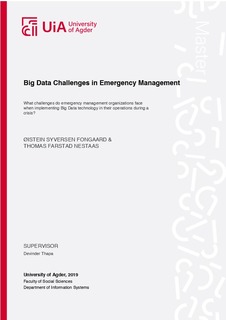| dc.description.abstract | The use of Big Data technologies has been more common in recent years, spreading across other fields than just the business sector. Emergency management organisations are seeking to utilise technologies that can improve their response and situational understanding during crises and disasters. Big Data and Big Data Analysis are working its way into the field of emergency management as well. Innovation and new technology results in new opportunities that need to be explored, but it is just as important to be aware of its challenges and limitations. This study will address the challenges emergency management organisations that use Big Data technology are facing. The following research question was formulated for the study: What challenges do emergency management organisations face when implementing Big Data technology in their operations during a crisis? To answer this question, we have conducted a qualitative study where we have interviewed informants in emergency management organisations and relevant research facilities. These informants have insight in how Big Data is used in emergency management, with its subsequent challenges. A total of 16 informants were interviewed in semi-structured interviews. The literature review reveals that the challenges with implementing Big Data in organisations can be divided into data challenges, process challenges and management challenges. The literature review provided us with a basis for our study, and the comparison of literature with the findings from the data collectionresulted in a revised model presenting Big Data challenges in emergency management.Findings from the study concludes with a conceptual classification of Big Data challenges in emergency management. The data and process challenges revealed in the literature review were kept. Data challenges include volume, velocity, variety, variability, veracity, visualisation,and value. Process challenges include data acquisition & warehousing, data mining & cleansing, data aggregation & integration, analysis & modelling, anddata interpretation. The management challenge of data ownershipis not considered as a challenge in emergency management, because the population are willing to sacrifice such rights in the course of a disaster where lives are at stake. This leaves the management challenges of privacy, security, data governance, data &information sharing, and cost/operational expenditures. In addition, the study results in three new challenges being added to the existing. The first, data access,is a data challenge which refers to problems relating to being unable to collect a necessary volume of information. The second, data neutrality, is a process challenge that refers to that no information is objective, it is always tainted and there is always someones data collection behind it. The third, time pressure is a management challenge that refers to the speed imperative that occurs by the nature of disasters and its connection the risk of losing lives. We provide four recommendations on how practitioners can overcome some of the mentioned challenges. We recommend organisations using Twitter data as their data source to look into data quality assurance tools such as TweetCred to overcome challenges relating to data veracity. Challenges relating to data access caused by communication networks being knocked out, can be used as information in nature disasters like typhoons or earthquakes, in the way that the areas not producing any data probably are the most critical areas affected by the disaster. To handle challenges related to data and information sharing we recommend that emergency management organisations seek towards common data standards such as Humanitarian Exchange Language (HXL). In addition, we recommend emergency management organisations to develop techniques to provide fast and easy-to-read
Vvisualisations of the analysed data thatis suited to their personnel in the field, to maintain a data driven crisis response. Suggestions for future research includes an empirical evaluation of the concluding conceptual classification of Big Data challenges in emergency management provided inthis study. Further, an analysis of the Big Data challenges related to the different terms of emergency, disaster and crisis to see if there is any differences between the situations, as well as differences in other phases of a disaster, where this study only has examined the response phase of the disaster | nb_NO |

